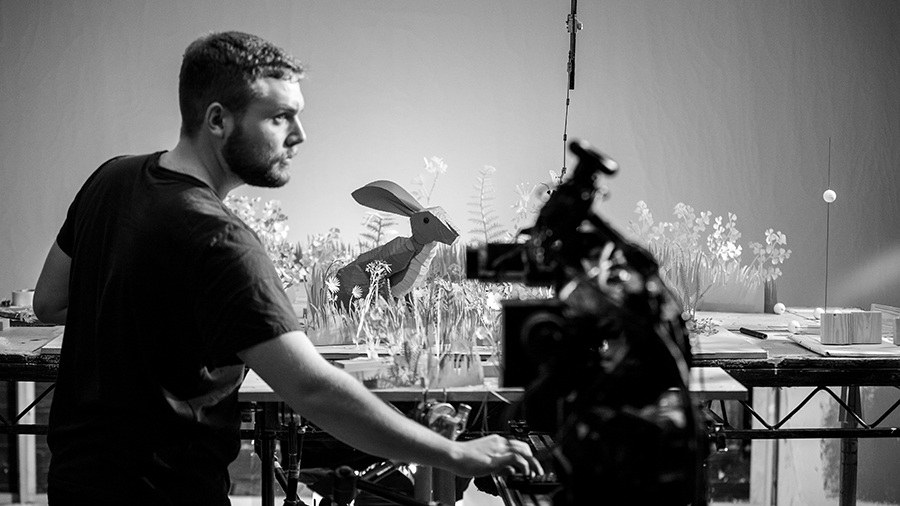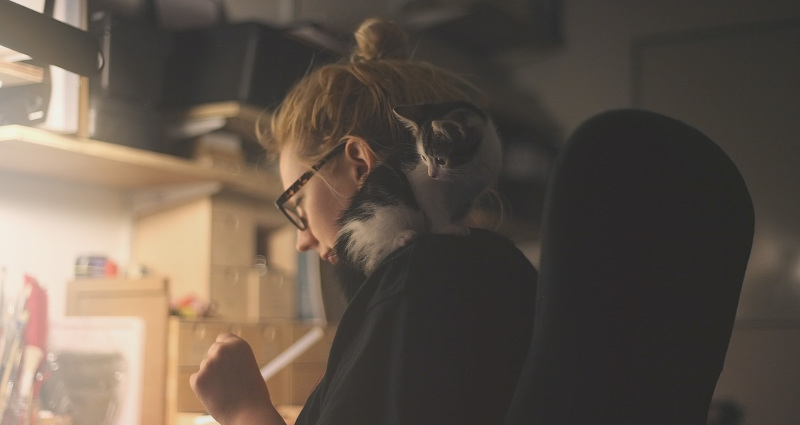New Shooting People Collaboration with Animators Luke George and Emma Rose-Dade
At Shooting People HQ we decided that it would be helpful for people who were new to the site to get a sense of who the community is, and to illustrate visually how the community is made up of so many different creative collaborators, right across the industry. We were also personally transfixed by paper animation at the time and when we came across the work of Emma and Luke, we got in touch to see if they might consider making a short video for us. Not only did they supersede all our expectations (on a very tight budget), but they were incredibly open, remarkably inventive, and also super generous in offering to share their thoughts on their working process.
Below, we’ve shared some more details on how this talented trio (including Adam, their brilliant composer) pull their work and ideas together.
Both of you work individually as well as a team. What benefits and challenges do you get when working on projects together, and how do you split your roles?
A major benefit of our working relationship is that we come from slightly different creative backgrounds – Luke from Graphic Design and Emma from photography. Our combined knowledge and experience compliment each other very well.
We break our roles up to suit the particular job, in this case it made sense that Emma took charge of the organisation, buying and art department whilst Luke focused on designing the shoot, light and edit. We cross over roles wherever useful.
It seems like their are so many multiple disciplines animators develop, or need to develop. What specific animation skills (also software and kit) did you use in creating the Shooting People video?
The multi-discipline nature of stop-motion is what drew us both to it in the first place. It gives us a way to make films whilst incorporating a lot of our skills and interests, like photography, lighting, design, animation, and a healthy dollop of problem solving.
We capture frames using dragonframe, which is the industry standard and packed full of useful features designed to make the process as easy as possible. We used a Canon 5D Mk II with an old 85mm manual lens. We also borrowed a motion control slider from our stop-motion pals, Parabella. We lit it with various combinations of dedos for spots and keys, an Arri 300 for general soft fill and an LED panel for some backdrops.
Paper Animation! We adore it. What it is about paper animation you guys love?
We really love paper animation because it’s quite an accessible material. Once you know its limitations and quirks it’s a quick and versatile way of making models.
Often people have very little idea how much time goes into crafting work like this. Can you give us a sense of what’s involved in creating one of the sequences for the video?
We created a storyboard to rough out the design and plan the animation so we only shoot what we need. We then finalised the designs in illustrator to be cut out of paper by our robot slave. We then start setting up the camera, moving into different positions to check the composition and sort out all the rigging for the animatable elements. As the animation was all super simple in this film, it actually ended up being one of the quickest stages of the process, which is very rarely the case! We like to try and do everything in camera, keeping the post work to a minimum.
What was your thinking on how to light the film? And what was the most difficult challenge with the piece?
We wanted to keep the lighting simple. We didn’t have loads of space to shoot in so we couldn’t go too bananas. The very talented DOP Malcolm Hadley kindly gave us his opinions and advice on how to light our sets, he even lent us a bit of kit.
We have members who are live action or documentary filmmakers – or even writers – who are keen to collaborate with animators. From an animators perspective, what’s the best approach and how can this partnership work best for everyone?
It totally depends on the project really. If the collaborator had a specific idea in mind, the more information they can give, the better. Storyboards, design sheets, timings, sound files etc are all super useful. Equally though, if they aren’t sure or aren’t familiar with animation then they should take the animator’s advice on board. Every project’s circumstances are different, but transparency and good communication are always key.
The soundtrack and sound design was such a surprise for us. We adored it. How did you come to collaborate with Adam? And how did that process work?
We were aware of Adam through his collaboration with friends of ours and really liked his work. We got in touch with him and he was keen to get involved.
Working with Adam was great because he understood the project and the vibe we wanted straight away. After a meeting where we talked through the project and showed him the animatic, we emailed back and forth with him sending us drafts. He was very quick and it wasn’t long before we had something we all liked.
Adam, what was your approach to creating the soundtrack for the film? And did it change along the way, or were you always clear from the start?
Often a client knows the exact track they wish they could use but can’t afford. In these instances I work best off references. Luckily, Luke and Emma had already made a great playlist featuring artists like Lemon Jelly and Cinematic Orchestra, tracks that captured the mood they wanted to convey for the film.
The edit was already locked with each scene cutting every 4 seconds which meant the tempo would fit 120 BPM very neatly. I tried to make the music shift with each cut; sweeping strings in the romantic scene, triumphant brass in the arctic explorer scene and so on. I’ve been listening to a lot of Henry Mancini so these motifs were very small nods to his amazing classic film scores.
I managed to get the essence of the track in my first attempt and we ending up only doing seven drafts which is very few compared to most jobs I have worked on.
From a composer and sound designer’s point of view, sound is so key to elevating a film. What’s the best approach for directors to get the best out of this partnership?
For me, communication and using appropriate vernacular are the two essential tools for quickly conveying an idea and getting the desired result.
Is the sound high or low pitched? Is the timbre too harsh or too soft? Give an approximation of what it sounds like. At one point Luke told me to “get rid of the organ sound” in the track, it didn’t matter that it wasn’t actually an organ he was hearing, I could navigate the myriad of sounds and isolate his criticism easily.
Most people actually have a far better musical vocabulary than they let themselves believe. Be specific where possible and time stamp your criticisms. These things should always be a collaboration where you both are learning all the time.
I once had a job where the feedback came back as a solid essay of changes that kept referring to one specific sound as “the bong bong bong”. This phrase was repeated about five times and I literally had no idea what they were talking about.
Thankfully Luke and Emma were a dream to work with, giving clear and direct instructions while giving me the freedom to use my creative judgement where necessary.
Luke, you recently did animation work for Wes Anderson’s latest feature Isle of Dogs. We KNOW your clouds made it into the trailer (Woop!). Are working on features like this a key part of your future plans or are these challenging decisions because of the huge time commitments? And, most importantly, did you meet Wes?!
Yes, that eight second explosion took over a week to shoot and got to about 4 ft high! Unfortunately I didn’t get the chance to meet Wes as he only seemed to turn up when I was off doing something else!
I like to keep my options open and my ear close to the ground. I’m looking to develop my character animation skills, but I consider myself a bit of a generalist, I just like to get stuck in. I’m currently working in Manchester making armatures for a new kids TV series.
Emma, you have a background in fine art and photography and you’ve also worked as an Art Director on films. Is this also something your keen to pursue more of, or is animation and model-making where your heart is?
Stop motion animation is where my heart is, as a medium it allows me to photograph, paint, model make, etc. I get to do all the creative things I enjoy doing. Art Directing is just a natural progression from model making on stop-motion projects and I very much look forward to doing it more in the future.
Adam, what’s coming up for you? And do you prefer to spend more of your time composing or sound designing, or are the two often melded for you?
As always I’m trying to write an album I am satisfied with (I release music under the name Adam Halogen). So far I have written and scrapped about five, which I guess is progress! I’ve just released a remix of Hard To Find by Strong Asian Mothers which I’m really happy with.
I’m always looking for opportunities to score for films wherever possible, so indie filmmakers please get in touch! No matter the budget.
Most of the music I make is for advertising which doesn’t boast a lot of creative freedom or originality. There are rare projects that truly meld sound design and music into one inseparable beast. My proudest example of this would be my collaboration with That Jam and Moon Man Studios on our film The Sleeping Field which we were lucky enough to win Gold Prize for music at the Berlin Fashion Film Festival.
Thank you all for taking the time to share with us.
Check out more of the work from this brilliant trio at:


